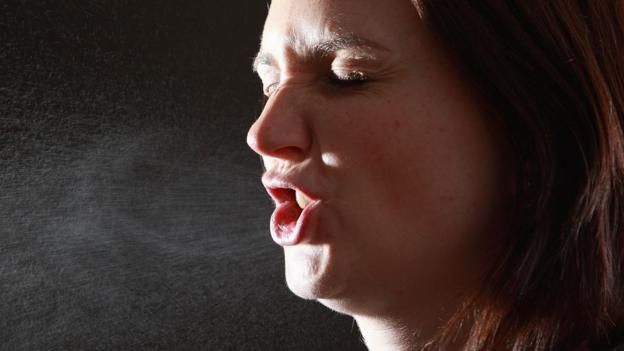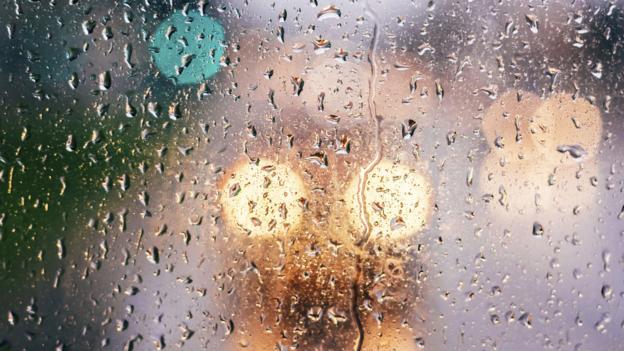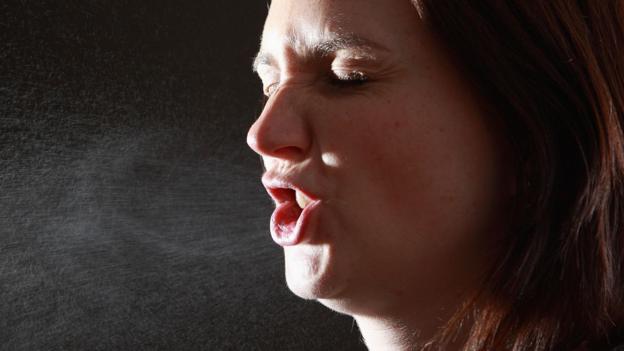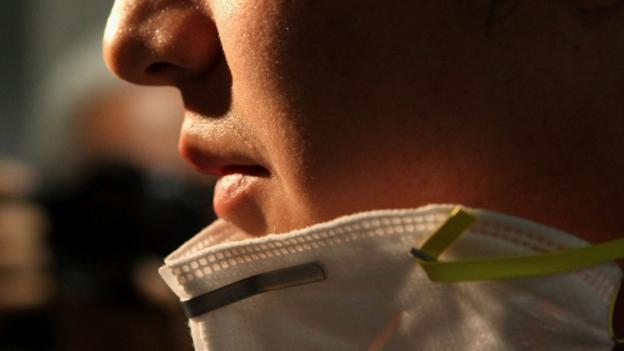BBC: 流感在冬天传播的真实原因
流感在冬天传播的真实原因
-
2015年 10月 27日
 Image copyright spl
Image copyright spl
每当夏去秋来,落叶飘零,它都会准时出现。随着温度降低,阳光渐弱,鼻涕也会随之而来。如果病情不重,那就只是一场感冒,会让我们的喉咙感觉有如刀刮过一样;如果你不幸病情较重,整个身体都会发高烧,四肢也会感觉疼痛,这种情况可能持续一周甚至更长时间。这说明我们得了流感。
流感季节总是很有规律,而且总会影响很多人。但即便如此,科学家对于寒冷的天气为什么有助于流感病菌的传播却知之甚少,这着实令人意外。
然而,过去5年间,他们终于找到了答案,这或许有助于阻止流感的大范围爆发——这一切的核心都源自你打出的喷嚏在空气中的传播方式。
人类的确应当尽早加深对流感的认识;每个流感季节,全世界都有多达500万人患病,其中约25万人会因此丧命。流感的破坏力之所以如此巨大,部分原因在于流感病毒的变异速度极快,往往令我们的身体对下一季的菌株措不及防。
“我们体内的抗体已经无法识别这些病毒——所以我们失去了免疫力。”布里斯托大学的简·梅茨(Jane Metz)说。这也加大了开发疫苗的难度,虽然完全可以为每一种菌株都设计一种新的疫苗,但政府往往无法说服足够的人注射疫苗。

倘若能够更好地了解流感为什么在冬季流行,到了夏季却销声匿迹,医生便可找到简单的方法来抑制它的传播。之前的理论都集中于我们自身的行为。我们冬天会在室内停留更长时间,因而会与可能携带病菌的人更近距离的接触。
到了冬天,我们也更有可能乘坐公共交通工具,例如——当紧靠着唾沫飞溅的路人时,当车窗上的雾气混入了他们的咳嗽或喷嚏时,我们便很容易置身于流感传播的引爆点之中。
还有一个流行的观点则把分析重点集中于我们的生理机能:寒冷的天气会导致你的身体丧失对传染病的抵抗力。由于冬天日照时间缩短,我们体内的维生素D含量可能降低。由于维生素D有助于加强我们的免疫系统,因此这种营养物质的缺乏导致我们更容易患传染病。
另外,在冷空气中呼吸时,鼻腔内的血管也有可能收缩,避免损失热量。这有可能阻碍白细胞(对抗病菌的斗士)到达鼻粘膜,使之无法杀死我们吸入的病毒,让病菌得以在不知不觉间绕过人体的防御系统。(或许正因如此,所以当我们湿着头发出门时很容易感冒。)

虽然这些因素都在流感的传播中扮演了一定的角色,但分析表明,这些理论依然无法完全解释每年都会出现的流感季节。事实上,真正的答案或许隐藏在我们呼吸的隐形空气中。由于热力学定律,冷空气携带的水蒸汽将会减少,并在到达“露点”后变成雨水降落下来。
所以,尽管到了冬天,外面的天气看起来更潮湿了,但由于空气湿度降低了,所以空气本身反而更加干燥。过去几年的一系列研究表明,这些干燥的环境似乎为流感病毒的生长和传播创造了绝佳的环境。
例如,科学家已经通过实验研究了流感在豚鼠之间的传播途径。在潮湿的空气中,流感病毒难以积聚势头,而在干燥的空气中却会像野火般迅速蔓延。
将最近30年的气候记录与健康档案进行对比后,哥伦比亚大学的杰弗里·沙曼(Jeffrey Shaman)和他的同事发现,流感爆发几乎总是伴随着空气湿度的下降。
事实上,这两个图形的重叠度极高,“几乎可以用一个图形完全覆盖另一个。”梅茨最近与亚当·费恩(Adam Finn)共同为《传染病期刊》(Journal of Infection)评估了所有的证据。这一发现已经得到了反复的验证,包括2009年爆发的猪流感。
这似乎违反直觉——我们通常认为,潮湿的天气容易使人生病,而不是为我们提供保护。
要理解背后的原因,就需要了解咳嗽和打喷嚏的动力学特性。当我们因为得了感冒而咳嗽或打喷嚏时,会从鼻子和嘴巴喷出许多微粒。
在潮湿的空气中,这些微粒可能相对较大,很容易落到地面上。但在干燥的空气中,这些微粒会分解成更小的微粒——最终小得足以在空中漂浮好几个小时,甚至好几天。(这有点像把喷头调到最细的那一档上产生的喷雾。)
正因如此,到了冬天,我们吸入的空气中就会混入最近进入房间的所有人通过呼吸道排出的死细胞、粘液和病毒。
另外,空气中的水蒸气本身似乎也会对病毒构成威胁。通过改变一团粘液的酸度或盐度,湿润的空气或许就可以瓦解病毒的表面,使之失去攻击人体细胞的常用武器。相比而言,病毒能在干燥的空气中漂浮好几个小时,直至被我们吸入呼吸道,并在我们喉咙的细胞里安家。
但也有一些例外情况。虽然飞机上的空气通常都很干燥,但似乎并不会增加患流感的风险——或许是因为空调本身可以过滤病菌,使之无法流通。
而且,尽管干燥的空气似乎能在欧洲和北美的温带地区促进流感的传播,但在更靠近赤道的地方却产生了一些矛盾的结果,表明病菌在那些地方的活动方式可能略有不同。

有一种观点认为,在特别温暖湿润的赤道气候中,病毒最终会贴附在室内的更多表面上。所以,尽管流感病毒不能在空气中轻易生存,但它却能存活于你所触及的任何一个表面,使之更有可能通过手进入我们的口腔。
但至少在北半球,可以根据这些发现设计一种简单的方式,在病菌仍然漂浮在空气中的时候将其消灭。当泰勒·科普(Tyler Koep)就职于明尼苏达州罗切斯特市的梅约诊所时,他曾经估计,只要在学校里使用空气加湿器一个小时,就能杀死30%漂浮在空气中的流感病毒。
还可以采取其他一些类似的措施,例如在医院大厅或公共交通工具等流感传播的热点地区泼洒冷水。“这可以抑制因为病毒的变异而每隔几年爆发一次的严重流感疫情。”他说,“疫情会导致企业停工、学校停课、健康受损,潜在影响十分巨大。”

沙玛目前正在展开进一步的尝试,但他认为,应该采取更加微妙的平衡措施。“尽管提高湿度可以降低流感病毒的存活率,但其他的病原体却会因为湿度的升高而更加活跃。”他说,“所以在加湿过程中必须保持谨慎——这并不是有利无害的。”
科学家们都在强调,疫苗和良好的个人卫生仍是保护自己的最好方式;使用水蒸气杀死病菌只是额外开辟的一条战线。但当你要对付像流感病毒那样善变而无处不在的敌人时,就需要动用所有可以使用的武器。
请访问 BBC Future 阅读 英文原文。
(责编:友义 )
吃与活注: 英文原文有原始研究的链接。
It begins as surely as the leaves dropping off the trees. As the mercury drops and the sunlight fades, the sniffles set in. At best, it’s just a cold that leaves us with the strange feeling that we’ve swallowed a cheese grater; if we’re unlucky, our body is wracked with a high fever and aching limbs for up a week or longer. We have flu.
The flu season arrives so predictably, and affects so many of us, that it’s hard to believe that scientists have had very little idea why cold weather helps germs to spread. Over the last five years, however, they have finally come up with an answer that might just offer a way to stem the tide of infection – and it revolves around a rather grim fact about the ways that your sneezes linger in the air.
The fact that it is simply colder in winter can’t explain the yearly flu season
A new understanding of influenza couldn’t come quickly enough; worldwide, up to five million people catch the illness each flu season, and around a quarter of a million die from it. Part of its potency comes from the fact that the virus changes so quickly that the body is rarely prepared for the next season’s strain. “The antibodies we’ve built up no longer recognise the virus – so we lose our immunity,” says Jane Metz at the University of Bristol. It also makes it harder to develop effective vaccines, and although you can engineer a new jab for each strain, governments often fail to persuade enough people to take it up.
The hope is that by understanding better why flu spreads in winter, but naturally fades in summer, doctors could find simple measures to stop its spread. Previous theories had centred on our behaviour. We spend more time indoors in the winter, meaning that we’re in closer contact with other people who may be carrying germs. We’re more likely to take public transport, for instance – and as we’re pressed against spluttering commuters, misting up the windows with their coughs and sneezes, it’s easy to see how this could send us over a tipping point that allows flu to spread through a population.
Without much sunlight, we may run low on Vitamin D, weakening the immune system
Another popular idea concerned our physiology: the cold weather wears down your body’s defences against infection. In the short days of winter, without much sunlight, we may run low on Vitamin D, which helps power the body’s immune system, making us more vulnerable to infection. What’s more, when we breathe in cold air, the blood vessels in our nose may constrict to stop us losing heat. This may prevent white blood cells (the warriors that fight germs) from reaching our mucus membranes and killing any viruses that we inhale, allowing them to slip past our defences unnoticed. (It could be for this reason that we tend to catch a cold if we go outside with wet hair.)
While such factors will both play some role in transmission, analyses suggested that they couldn’t completely explain the yearly emergence of flu season. Instead, the answer may have been lying invisible in the air that we breathe. Thanks to the laws of thermodynamics, cold air can carry less water vapour before it reaches the “dew point” and falls as rain. So while the weather outside may seem wetter, the air itself is drier as it loses the moisture. And a steady stream of research over the past few years has shown that these dry conditions seem to offer the perfect environment for the flu virus to flourish.
Lab experiments, for instance, have looked at the way flu spreads among groups of guinea pigs. In moister air, the epidemic struggles to build momentum, whereas in drier conditions it spreads like wildfire. And comparing 30 years’ worth of climate records with health records, Jeffrey Shaman at Columbia University and colleagues found that flu epidemics almost always followed a drop in air humidity. In fact, the overlap of the graphs was so close, “you could pretty much put one on top of each other,” says Metz, who together with Adam Finn, recently reviewed all the evidence for the Journal of Infection. The finding has now been replicated many times including analyses of the 2009 Swine flu pandemic.
In winter, you are breathing a cocktail of dead cells, mucus and viruses from everyone who has visited the room recently
Should I wear a facemask?
What studies say
Anytime you walk into a public place, you are breathing in a fine mist of other people’s coughs and sneezes – which can hang around in the air for days. Face masks are a common precaution to stop you breathing in the germs – but do they work?
To find out, one Australian study targeted the families of people turning up at hospital with influenza. Relatives who wore surgical masks were 80% less likely to become infected themselves.Although later papers have mostly confirmed the results, it seems that it is only effective alongside hand-washing and generally good hygiene. Otherwise, it’s a little like locking all your windows while leaving the front door wide open – you are missing the most obvious line of defence.
That’s counter-intuitive – we normally think that the damp makes us ill, rather than protects us from disease. But to understand why, you need to grasp the peculiar dynamics of our coughs and sneezes. Any time we splutter with a cold, we expel a mist of particles from our nose and mouths. In moist air, these particles may remain relatively large, and drop to the floor. But in dry air, they break up into smaller pieces – eventually becoming so small that they can stay aloft for hours or days. (It’s a bit like the mist you get when you turn a hose pipe to its finest spray.) The result is that in winter, you are breathing a cocktail of dead cells, mucus and viruses from anyone and everyone who has visited the room recently.
What’s more, water vapour in the air seems to be toxic to the virus itself. Perhaps by changing the acidity or salt concentration in the packet of mucus, moist air may deform the virus’s surface, meaning that it loses the weaponry that normally allows us to attack our cells. In contrast, viruses in drier air can float around and stay active for hours – until it is inhaled or ingested, and can lodge in the cells in your throat.
There are some exceptions to the general rule. Although the air on aeroplanes is generally dry, it does not seem to increase the risk of catching influenza – perhaps because the air conditioning itself filters out any germs before they have a chance to circulate. And although the dry air seems to fuel the spread of flu in the temperate regions of Europe and North America, some contradictory results suggest the germs may act somewhat differently in more tropical areas.
In particularly warm and wet conditions, the virus may end up sticking to more surfaces within a room
One explanation is that in particularly warm and wet conditions of a tropical climate, the virus may end up sticking to more surfaces within a room. So although it can’t survive in the air so well, the flu virus could instead be thriving on everything that you touch, making it more likely to pass from hand to mouth.
But in the northern hemisphere at least, these findings could offer a simple way to kill the germs while they are still hanging in the air. Tyler Koep, then at the Mayo Clinic in Rochester, Minnesota, has estimated that simply running an air humidifier in a school for one hour could kill around 30% of the viruses flying around the air. Similar measures could (almost literally) pour cold water on other disease hotspots – such as hospital waiting rooms or public transport. “It would be a way of curbing the large outbreaks that occur every few years as the flu virus changes,” he says. “The potential impact in the cost of work days missed, schools days missed, and healthcare, would be substantial.”
Shaman is now working on further trials, though he thinks that it will involve a tricky balancing act. “Though higher humidity is associated with lower survival rates for influenza, there are other pathogens, such as pathogenic mould, that thrive at higher humidity,” he says. “So care must be taken with humidification – it's not solely beneficial.”
The scientists are keen to emphasise that measures like vaccines and good personal hygiene are still the best ways to protect yourself; using water vapour to kill the germs would just offer an additional line of attack. But when you are dealing with an enemy as mercurial and pervasive as the flu virus, you need to use every possible weapon in your arsenal.




